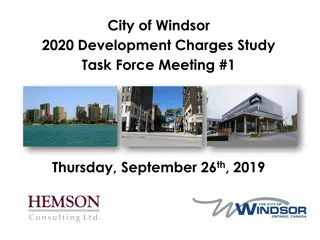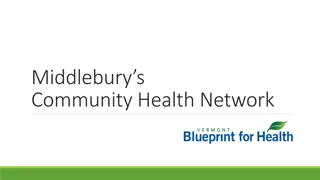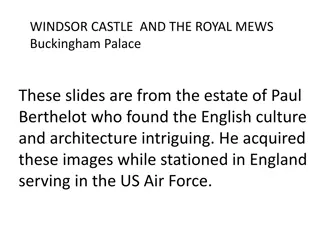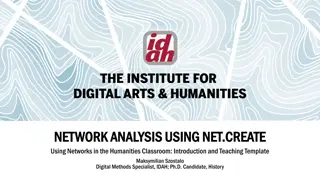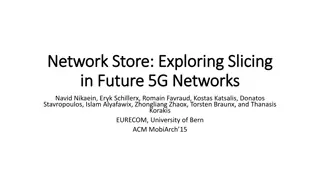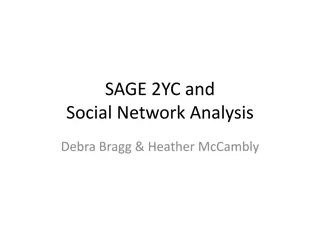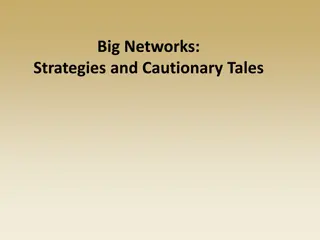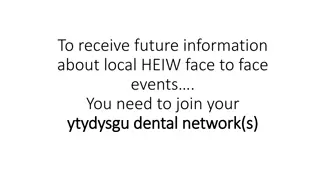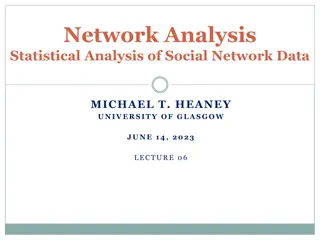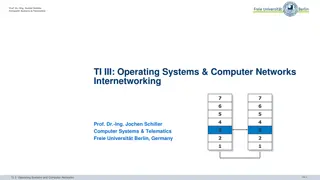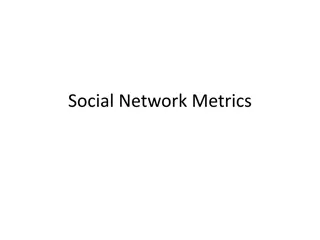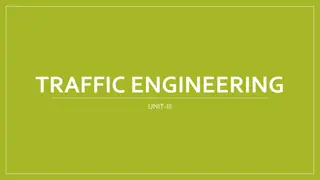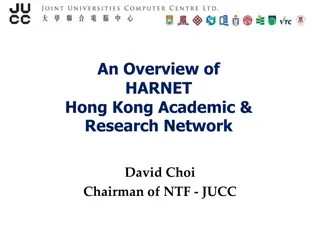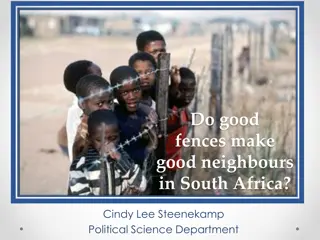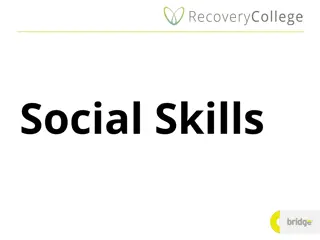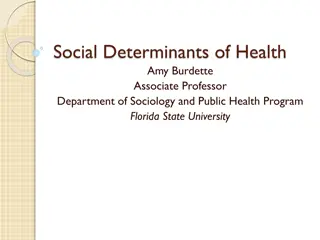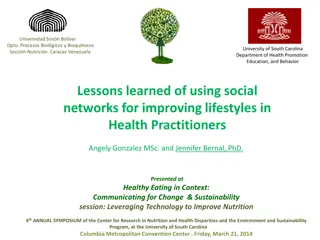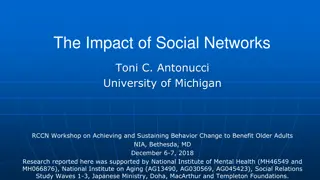Understanding Community Health Networks in Windsor: A Social Network Analysis
Exploring the network of organizations in the Windsor Health Service Area (HSA) to support population and individual health through collaboration and relationships. The study delves into the impact, connections, and characteristics of these networks, utilizing social network analysis to quantify, visualize, and understand community dynamics. Network development methodologies, survey participation rates, and the role of Community Health Teams are discussed.
Download Presentation

Please find below an Image/Link to download the presentation.
The content on the website is provided AS IS for your information and personal use only. It may not be sold, licensed, or shared on other websites without obtaining consent from the author. Download presentation by click this link. If you encounter any issues during the download, it is possible that the publisher has removed the file from their server.
E N D
Presentation Transcript
Windsors Community Health Network WINDSOR HEALTH SERVICE AREA FY2015
Objective Objective Describe the network of organizations that has emerged in each Blueprint HSA to support population and individual health, focusing on modes of collaboration and relationships between organizations Background and Key Questions This study is the first step towards answering key questions about the networks that are active in Blueprint communities: What role did investment in core Community Health Teams have in seeding these larger networks? How are the participating organizations connected to each other? How are these relationships maintained and reinforced how durable are they? What characteristics do the most successful networks share? What impact do these networks have on individual and population health? 2
Social Network Analysis To address the key questions of this study, we use social network analysis. What is social network analysis? Social network analysis quantifies communities and in particular the relationships between actors in a community. What is a network graph? A network graph shows connections between individuals or, in this case, organizations. What can social network analysis tell me? Social network analysis can help describe a community and explore the relationships that make up that community. Once these relationships are visible, we can start to look for patterns, as well as changes over time, in how the most effective networks coalesce and how they create change. Our observations of network graphs and understanding of community network data will inform our planning of collaboration for community health improvement. 3
Network List Development In this Health Service Area (HSA) the methodology began with network bounding that included core health organizations as well as a wide-range of social service organization and community service organization. The network membership list began with the 2013 study list provided by the Blueprint Project Manager, added write-ins from 2013 study responses, and additionally added organizations (if not already represented) from the Unified Community Collaborative. Organization representative contact information was collected from Project Managers and publicly available sources such as organization websites. 4
Survey Participation In this health service area, invitations and reminders were sent via Survey Monkey. Invitations Sent Surveys Started Response Rate Completed Surveys Completion Rate 80 40 50% 31 78% 5
Participating Organizations Aging in Hartland MAHHC Windsor Connection Resource Center State of VT AHS Department of Children and Families (DCF) Visiting Nurse and Hospice for Vermont and New Hampshire (VNH) Bayada Home Health Care & Hospice MAHHC Mt. Ascutney Physicians Practice State of VT AHS DCF Economic Services Division Windham & Windsor Housing Trust Cedar Hill MAHHC Mount Ascutney Prevention Partnership (MAPP) Windsor County Court Diversion State of VT AHS Department of Corrections (DOC) Change the World Kids MAHHC Ottauquechee Health Center Windsor Food Shelf Granite United Way State of VT AHS Department of Disabilities, Aging and Independent Living (DAIL) Neighbors Helping Neighbors Windsor Jr./Sr. High School Habit OPCO West Lebanon Ottauquechee Health Foundation Windsor Police Department State of VT AHS Department of Vermont Health Access (DVHA) Health Care & Rehabilitation Services of Vermont (HCRS) Reading and Albert Bridge School Windsor School District State of VT AHS DVHA Vermont Chronic Care Initiative (VCCI) HCRS Children s Integrated Services Senior Solutions Woodstock Union Middle School Historic Homes of Runnemede Southeastern Vermont Community Action (SEVCA) MAHHC Spoke* State of VT Vermont Department of Health (VDH) Mt. Ascutney Hospital and Health Center (MAHHC) Southern Vermont Area Health Education Center (AHEC) SASH* Thompson Senior Center Windsor Central Supervisory Union* MAHHC Case Management Springfield Area Parent Child Center Turning Point Recovery Center Bold indicates response to the survey MAHHC Emergency Department Springfield Housing Authority U.S. Department of Veterans Affairs (VA) White River Junction VA Medical Center * Indicates respondent write-in MAHHC Blueprint Community Health Team Springfield Housing Authority SASH Vermont Adult Learning MAHHC Pediatrics Springfield Supportive Housing Vermont Psychiatric Survivors MAHHC Volunteers in Action State of VT Agency of Human Services (AHS) 6
Network Maps WINDSOR HEALTH SERVICE AREA 7
Our organizations . . . HAVE PATIENTS/CLIENTS IN COMMON Node color shows Degree Node size shows Betweeness Centrality 8
Our organizations . . . SHARE INFORMATION ABOUT SPECIFIC PATIENTS/CLIENTS Node color shows Degree Node size shows Betweeness Centrality 9
Our organizations . . . SHARE INFORMATION ABOUT PROGRAMS, SERVICES AND/OR POLICY Node color shows Degree Node size shows Betweeness Centrality 10
My organization SENDS REFERRALS TO this organization My organization RECEIVES REFERRALS FROM this organization Node color shows Degree Node size shows Betweeness Centrality 11
Our organizations . . . SHARE RESOURCES (e.g. joint funding, shared equipment, personnel or facilities) Node color shows Degree Node size shows Betweeness Centrality 12
FULL NETWORK all questions Node color shows Network Neighborhood Node size shows Betweeness Centrality Mt. Ascutney Hospital and Health Center is the most central organization in the full network, and is alone at the center to a degree not seen in most health service areas. Network neighborhoods appear to be formed around populations served. Elder care organizations and housing are clustered in the red network neighborhood. Child and family services, including schools, are clustered in the blue network neighborhood. The green network neighborhood is a mix of state services and substance abuse recovery services. 13
Full Network Statistics Avg. Degree 13.852 Avg. Weighted Degree 34.63 Network Diameter 3 Graph Density 0.271 Modularity 0.169 Avg. Clustering Coefficient 0.586 Avg. Path Length 1.761 14
Organization Statistics Organizations Ranked by Betweeness Centrality Betweenness Centrality is a measure of how likely an organization is to appear on the shortest path between any two randomly selected network members. Mt. Ascutney Hospital and Health Center (MAHHC) Springfield Housing Authority - SASH Health Care & Rehabilitation Services of Vermont (HCRS) State of VT - AHS - DVHA - Vermont Chronic Care Initiative (VCCI) Senior Solutions Highest In-Degree In-Degree represents the total number of connections directed in, towards an organization. These are connections reported by another organization, with the exception of referrals from which would be reported by the organization itself. 14 Mt. Ascutney Hospital and Health Center (MAHHC) 8 Health Care & Rehabilitation Services of Vermont (HCRS) 7 MAHHC - Case Management 5 MAHHC - Ottauquechee Health Center 5 MAHHC - Blueprint Community Health Team 15
Team Based Care WINDSOR HEALTH SERVICE AREA 16
Team-based care measures are more strongly positive than in last years study. Agreement that the community demonstrated the given qualities of an effective team increased 6-10% across all areas except Effective Communication, where agreement decreased 4%. In every measure, Windsor outperforms the state average. Team Based Care % of Respondents who "Agree" or "Strongly Agree" That Their Community Exhibits the Given Team Characteristics 100% 87% 87% 90% 81% 81% 80% 80% 77% 75% 80% 73% 69% 66% 70% 61% 60% 50% 40% 35% 40% 31% 30% 20% 10% 0% Shared Goals Mutual Trust Effective Communication Clear Roles Measureable Processes and Outcomes FY14 FY15 State Avg. FY15 17
Community Observations Write-in organizations included: other practitioners private, Green Mtn RSVP, local clergy, Woodstock Food Shelf (x3), Bridgewater Sustainable Earth Foundation, Barnard Helping Hands, Reading Food Shelf, Neighbors Helping Neighbors, HIV/HCV Resource Center, Good Beginnings, Aging in Hartland, Tyson Ladies Aide Group, Killington Elementary, Killington Seniors, Good Neighbor/Red Logan Clinic, Dartmouth Hitchcock Community Health, Alice Peck Day Community Health, Kings Daughters, Zack s Place, Reading Food Shelf, Prosper Ladies Group, Woodstock Rotary Many issues are identified, such as housing and dental repeat over and over sometimes without resolution Mt Ascutney s Blueprint Team is excellent very focused on person centered care and looks for collaborations to prevent duplication. Every day members of our Community Health Team which is the MAHHC CHT strive to learn more about and share information with each and every resource that we can in order to have the knowledge base to help each individual to meet their needs and health goals. The Blueprint work has improved information sharing and the opportunities to collaborate in Southern Vermont. We appreciate our partners and are exploring ways with intra-agency care management to better integrate services on behalf of our patients. Building nicely! School nurses are no longer in an effective role with the Blueprint . . . had more presence with Child Protection Teams. I think we do a great job through PATCH to communicate. I think the PATCH meeting is such a great tool and informative asset to the needs of our communities. Many families are getting duplicated services because families/communication lacking information another agency already in the home. Hard to rank MAHHC as separate entities as listed in the survey as we are small and work together so closely. 18
Closing Thoughts Cause for celebration A strong, cohesive team Clear leadership AND broad inclusion And more . . . Opportunities for improvement Measuring success What else? 19



